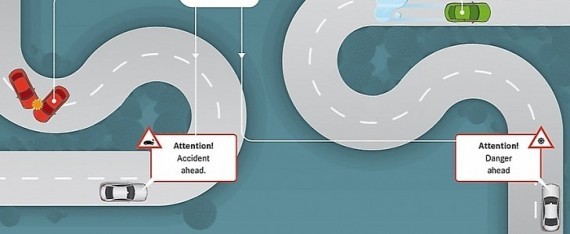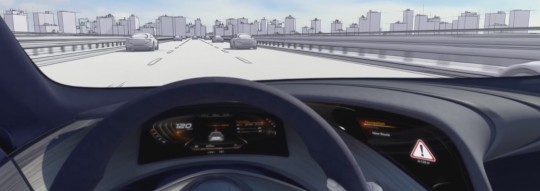 Before people start wearing tin foil caps to protect their thoughts from the cars that communicate with “X,” we decided to make a guide to explain what is with the fuss about these systems. In plain words, we will define what Car-To-X means, and what can it do for you. Moreover, you will also learn what it cannot do yet, and what it will never be able to do.
Before people start wearing tin foil caps to protect their thoughts from the cars that communicate with “X,” we decided to make a guide to explain what is with the fuss about these systems. In plain words, we will define what Car-To-X means, and what can it do for you. Moreover, you will also learn what it cannot do yet, and what it will never be able to do.
Just like self-driving cars, the technology dubbed Car-To-X communication is not something to fear. No matter how much you hate the expansion of some elements from the IT world entering your day-to-day life, this will not bother you. Instead, it should make the roads and cities of the world safer, while also cutting down on you commute time.
If there is something that can be done to reduce commuting times without using mysterious shortcuts every single day, only to find something blocking your way from time to time, we can say that this technology is exciting.
Think of it as a kind of Waze for your vehicle, but without relying on people to notify you of potential problems down the road. Evidently, there’s a catch – it will not tell you about police speed traps, like Waze might do if someone passed by them and had the time to introduce a warning.What is Car-To-X-Communication?
 Initially, the system was referred to as “Car-To-Car” technology. It was supposed to allow cars to “talk” to each other. It has been since enhanced with the ability to communicate with infrastructure. It happens automatically, seamlessly, and it is entirely wireless.
Initially, the system was referred to as “Car-To-Car” technology. It was supposed to allow cars to “talk” to each other. It has been since enhanced with the ability to communicate with infrastructure. It happens automatically, seamlessly, and it is entirely wireless.
Mercedes-Benz says that its system will be compatible with all the models in the brand’s portfolio, and some will be able to get it after they get sold, as an aftermarket upgrade.
Just like with any software, updates will turn the system into a valuable tool for day-to-day driving, without the users having to do anything extra on top of driving. The best bit about this scheme is that it will be integrated into autonomous cars, and it will also help them operate better when everyone has it.
The wireless communication will not be perceived by humans, who will only get the benefits of the robotic work. Cars will be able to advise each other that there is an accident on the road, or that a dangerous area has been detected (think of an oil slick in the apex of a corner). The other vehicles that get notified will be able to slow down ahead of the obstacle, or to avoid it without any sudden maneuvers. Once the hazard is gone (cameras will figure that out) the warning also disappears.How does it work?
 While “black magic” would be the answer to this question if you are an extreme version of an automotive purist, an informed petrolhead will provide you with a different answer. Instead of voodoo, sorcery, or some other dark force, Car-To-X communication works with an eSIM, which also allows the owner of the said vehicle to switch his or her mobile phone provider without having to replace the SIM card of the car.
While “black magic” would be the answer to this question if you are an extreme version of an automotive purist, an informed petrolhead will provide you with a different answer. Instead of voodoo, sorcery, or some other dark force, Car-To-X communication works with an eSIM, which also allows the owner of the said vehicle to switch his or her mobile phone provider without having to replace the SIM card of the car.
Sounds confusing? It is not. Think of connected cars as vehicles that have those USB devices that can connect a laptop to the Internet through a wireless connection over the cellular data network. Instead of fitting those units, connected cars get a permanent 4G(LTE) connection with an eSIM, which works using a subscription that provides a few years of free service.
The infrastructure elements work in the same manner, but they do not have to change their providers, and a cabled connection could also work for them. It is wise to note that those units will still need wireless transmission equipment, so using a wired link is not the best idea.
From there, all of the elements will connect to a secure Virtual Private Network. The latter allows a terminal (PC/smartphone/IoT device) to connect to a network with dedicated credentials, and with a specially designed IP.What can it do for you?
 You might have read about the Audi that can “talk” to traffic lights. That is just one example of Car-To-X Communication. With that precedent alone, a vehicle will know if there’s a point to shutting off the engine when the driver stops at a light, or just leaving it on for the few seconds it takes for the said light to turn green.
You might have read about the Audi that can “talk” to traffic lights. That is just one example of Car-To-X Communication. With that precedent alone, a vehicle will know if there’s a point to shutting off the engine when the driver stops at a light, or just leaving it on for the few seconds it takes for the said light to turn green.
Furthermore, when cars will drive themselves, an automobile will be able to slow down or accelerate if the light tells it that it has time to catch it on green.
Because the entire intersection will be monitored, the system will also be capable of informing vehicles of traffic jams, and the navigation of each car could re-route each driver to avoid the queue. Vehicles will also be able to tell cars that are driving the other way that they are heading for a traffic jam.
Cars will also know if there is a reckless driver up the road, and even if someone runs a red light. Before you realize, your automobile will be able to save your life or avoid a collision without having to brake with maximum force.
It will take some time growing used to the system that could slow down your car for no apparent reason, but you will reach your destination faster, and in a safer manner. A parking spot might be waiting for your car when it reaches the destination.What are the downsides?
 First of all, this system will add cost and complexity to vehicles. In turn, those added costs will come to infrastructure operators. In places where the infrastruct
First of all, this system will add cost and complexity to vehicles. In turn, those added costs will come to infrastructure operators. In places where the infrastructure is not at its best, Car-To-X might only work as Car-To-Car, and it might get even worse in remote areas, where the Internet is not available at all.
Another significant problem is that automakers will have to work together to set up a standard of communication, which is rather difficult if we look at their past.
We have about six different types of wiper arms in use today, and not even lug nuts are interchangeable. We are happy to see that the fuel filler works the same for all vehicles. One can only hope that this will happen to Car-To-X communication systems, but you cannot run apps from a Mac on a Windows PC, can you? Not without an emulation system that works terribly, mind you.
All of the advantages above will also increase the risk of hacking an automobile, but the systems available to consumers should reach an impressive level of safety by then. As long as users do not place malware in the system using USB sticks, and nobody could set a weak password, everyone should be safe.
In theory, a connected car has the capacity of informing the authorities if its operator was speeding. However, that part is not mentioned anywhere, and it is unlikely for this to happen with Car-To-X systems. Unfortunately, this could become the best speeding deterrent ever once these systems become mainstream.








